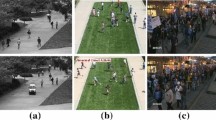Abstract
Sparse representation method has been well used in image analysis, restoration and recognition, and it has also been introduced to analysis of video crowd movements recent years. To improve its accuracy of detecting abnormal events in crowd videos, a double sparse representation method is proposed. The method has two sparse processes, one of them judges whether the region of interest is normal, the other finds out whether the region is abnormal. The two judgments will be processed by fuzzy integral to obtain a final result for this region. Experiments are proceed in different datasets to validate the advantages of our algorithm. The results show that our method achieves higher accuracy than previous methods which are used for analysis of video crowd movements.
J. Jiang—The work is supported by the National Natural Science Foundation of China (Projects No. 61171184 and 61201309).
Access this chapter
Tax calculation will be finalised at checkout
Purchases are for personal use only
Similar content being viewed by others
References
Ali, S., Shah, M.: A lagrangian particle dynamics approach for crowd flow segmentation and stability analysis. In: IEEE Conference on Computer Vision and Pattern Recognition, CVPR 2007, pp. 1–6. IEEE (2007)
Ali, S., Shah, M.: Floor fields for tracking in high density crowd scenes. In: Forsyth, D., Torr, P., Zisserman, A. (eds.) ECCV 2008, Part II. LNCS, vol. 5303, pp. 1–14. Springer, Heidelberg (2008)
Barron, J.L., Fleet, D.J., Beauchemin, S.S.: Performance of optical flow techniques. Int. J. Comput. Vis. 12(1), 43–77 (1994)
Cao, T., Wu, X., Guo, J., Yu, S., Xu, Y.: Abnormal crowd motion analysis. In: 2009 IEEE International Conference on Robotics and Biomimetics (ROBIO), pp. 1709–1714. IEEE (2009)
Cong, Y., Yuan, J., Liu, J.: Sparse reconstruction cost for abnormal event detection. In: 2011 IEEE Conference on Computer Vision and Pattern Recognition (CVPR), pp. 3449–3456. IEEE (2011)
Cong, Y., Yuan, J., Liu, J.: Abnormal event detection in crowded scenes using sparse representation. Pattern Recogn. 46(7), 1851–1864 (2013)
Daniyal, F., Cavallaro, A.: Abnormal motion detection in crowded scenes using local spatio-temporal analysis. In: 2011 IEEE International Conference on Acoustics, Speech and Signal Processing (ICASSP), pp. 1944–1947. IEEE (2011)
Hale, E.T., Yin, W., Zhang, Y.: A fixed-point continuation method for l1-regularized minimization with applications to compressed sensing. CAAM TR07-07, Rice University (2007)
Kim, J., Grauman, K.: Observe locally, infer globally: a space-time mrf for detecting abnormal activities with incremental updates. In: IEEE Conference on Computer Vision and Pattern Recognition, CVPR 2009, pp. 2921–2928. IEEE (2009)
Krausz, B., Bauckhage, C.: Loveparade 2010: automatic video analysis of a crowd disaster. Comput. Vis. Image Underst. 116(3), 307–319 (2012)
Lee, B.H., Koo, Y.H., Oh, J.Y., Cheon, J.S., Tahk, Y.W., Sohn, D.S.: Fuel performance code cosmos for analysis of lwr uo2 and mox fuel. Nucl. Eng. Technol. 43(6), 499–508 (2011)
Liu, X., Song, W., Zhang, J.: Extraction and quantitative analysis of microscopic evacuation characteristics based on digital image processing. Phys. A: Statist. Mech. Appl. 388(13), 2717–2726 (2009)
Mahadevan, V., Li, W., Bhalodia, V., Vasconcelos, N.: Anomaly detection in crowded scenes. In: 2010 IEEE Conference on Computer Vision and Pattern Recognition (CVPR), pp. 1975–1981. IEEE (2010)
Mehran, R., Oyama, A., Shah, M.: Abnormal crowd behavior detection using social force model. In: IEEE Conference on Computer Vision and Pattern Recognition, CVPR 2009, pp. 935–942. IEEE (2009)
Raghavendra, R., Del Bue, A., Cristani, M., Murino, V.: Abnormal crowd behavior detection by social force optimization. In: Salah, A.A., Lepri, B. (eds.) HBU 2011. LNCS, vol. 7065, pp. 134–145. Springer, Heidelberg (2011)
Rodriguez, M., Laptev, I., Sivic, J., Audibert, J.Y.: Density-aware person detection and tracking in crowds. In: 2011 IEEE International Conference on Computer Vision (ICCV), pp. 2423–2430. IEEE (2011)
Seyfried, A., Steffen, B., Klingsch, W., Boltes, M.: The fundamental diagram of pedestrian movement revisited. J. Stat. Mech: Theory Exp. 2005(10), P10002 (2005)
Steffen, B., Seyfried, A.: Methods for measuring pedestrian density, flow, speed and direction with minimal scatter. Phys. A: Statist. Mech. Appl. 389(9), 1902–1910 (2010)
Sugimura, D., Kitani, K.M., Okabe, T., Sato, Y., Sugimoto, A.: Using individuality to track individuals: clustering individual trajectories in crowds using local appearance and frequency trait. In: 2009 IEEE 12th International Conference on Computer Vision, pp. 1467–1474. IEEE (2009)
UnusualcrowdactivitydatasetofUniversityofMinnesota. http://mha.cs.umn.edu/movies/crowdactivity-all.avi
Wang, B., Ye, M., Li, X., Zhao, F., Ding, J.: Abnormal crowd behavior detection using high-frequency and spatio-temporal features. Mach. Vis. Appl. 23(3), 501–511 (2012)
Wu, S., Moore, B.E., Shah, M.: Chaotic invariants of lagrangian particle trajectories for anomaly detection in crowded scenes. In: 2010 IEEE Conference on Computer Vision and Pattern Recognition (CVPR), pp. 2054–2060. IEEE (2010)
**ong, G., Cheng, J., Wu, X., Chen, Y.L., Ou, Y., Xu, Y.: An energy model approach to people counting for abnormal crowd behavior detection. Neurocomputing 83, 121–135 (2012)
Zhu, H., Tang, X.: Classifier geometrical characteristic comparison and its application in classifier selection. Pattern Recogn. Letters 26(6), 829–842 (2005)
Author information
Authors and Affiliations
Corresponding author
Editor information
Editors and Affiliations
Rights and permissions
Copyright information
© 2015 Springer International Publishing Switzerland
About this paper
Cite this paper
Jiang, J., Tao, Y., Zhao, W., Tang, X. (2015). Abnormal Crowd Motion Detection Using Double Sparse Representations. In: He, X., et al. Intelligence Science and Big Data Engineering. Image and Video Data Engineering. IScIDE 2015. Lecture Notes in Computer Science(), vol 9242. Springer, Cham. https://doi.org/10.1007/978-3-319-23989-7_26
Download citation
DOI: https://doi.org/10.1007/978-3-319-23989-7_26
Published:
Publisher Name: Springer, Cham
Print ISBN: 978-3-319-23987-3
Online ISBN: 978-3-319-23989-7
eBook Packages: Computer ScienceComputer Science (R0)




